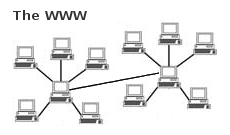If you’re reading this, then the World Wide Web has probably become a part of your daily life. The Web is an increasingly important tool companies use to reach customers and other stakeholders. This trend is sure to continue into the foreseeable future. To help with decision-making on Web related matters, it’s a good idea for managers and business owners to have, at least a basic understanding, of what the Web is and how it works.
What is the World Wide Web?
 Essentially, the World Wide Web (WWW) is made up of a lot of interconnected computers (via phone lines, cables, or satellites). Some of these computers are designed to serve out webpages. These computers are called web servers, which are usually running 24/7. Other computers, like the one you are using to read this text, are called clients. Client computers make requests to server computers, like asking for a web page and its associated graphics. The server computer responds by feeding (or serving) the web page data back to the client.
Essentially, the World Wide Web (WWW) is made up of a lot of interconnected computers (via phone lines, cables, or satellites). Some of these computers are designed to serve out webpages. These computers are called web servers, which are usually running 24/7. Other computers, like the one you are using to read this text, are called clients. Client computers make requests to server computers, like asking for a web page and its associated graphics. The server computer responds by feeding (or serving) the web page data back to the client.
The Internet is often confused with the World Wide Web. The Internet consists of a wide range of technologies including email, file data transfer, protocols (communications infrastructure) as well as the Web. The World Wide Web is just one component of the Internet.
Web Browsers
Web browsers are computer programs that are installed on client computers to request web page files from server computers. It’s the program you’re using to access this website and read this text. Once a request is made via the browser (by clicking a link or entering a web address in the “address bar”), the web server sever sends the requested data back to the browser. The browser then interprets the data and displays it on the screen.
Popular web browsers include Firefox, Chrome, Opera, Safari, Edge. Each of these browsers differ somewhat in terms of features, but their purpose is the same. They’re all meant to request and present web pages to the user.
“Mobile browsers” are web browsers designed for use on a mobile devices like PDAs and cell phones.
Website
A website is made up of a collection of files sitting on a web server. These files usually include:
- Image and/or video files
- Text files that tell the web browser how to layout the page and what text to include
- Script files (small programs) that add functionality or effects to the webpage
Website Hosting
The files that make up your website have to be put somewhere that people can access. This somewhere is a computer running web server software. The server takes incoming user requests and returns your website files to their browser. Web hosts are companies that rent space on their servers for you to store your website files on. The web host takes care of the necessary computer hardware, software and connections.
Website Address
 Lets say you have a website, how can people reach it? One answer is, by entering your website address (or “URL” in nerd-speak) into your browser’s address bar. A website has to have a unique address so that it can be found. Just as real world home addresses are unique to avoid confusion, website addresses have to be unique also.
Lets say you have a website, how can people reach it? One answer is, by entering your website address (or “URL” in nerd-speak) into your browser’s address bar. A website has to have a unique address so that it can be found. Just as real world home addresses are unique to avoid confusion, website addresses have to be unique also.
How do you get a unique address? By registering a domain name. Examples of domain names are “ibm.com” and “wikipedia.org”. Our domain name is “helpsme.com”. The helpsme.com domain name is mapped to the server that stores the files that makes up this website.
An organization named ICANN coordinates these domain names across the world. This is necessary so that when you type an address into your browser, you reach the website you were looking for.
Conclusion
The main ideas to understand are that:
- The World Wide Web is nothing more than a large number of interconnected client and server computers
- Websites are accessed by client computers via the web browser
- Each website has a unique addresse determined by its domain name
- Website files are stored on server computers that wait for requests from client computers
We have deliberately not gone into great technical detail here. Nevertheless, this article should give you a basic understanding of how the World Wide Web works and what’s required to have a website.